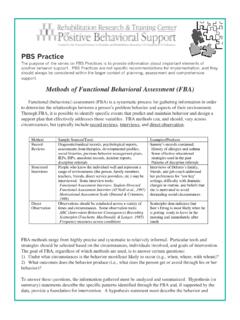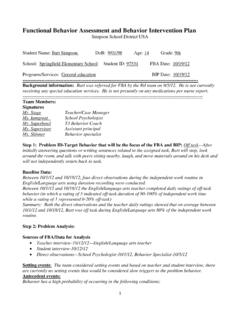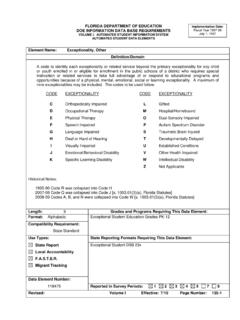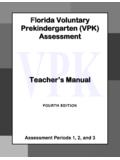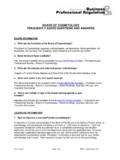Transcription of Facilitator’s Guide - APBS
1 facilitator 's Guide Positive Behavioral Support November, 1999. This is one of many publications available through the Bureau of Instructional Support and Community Service, florida department of education , designed to assist school districts, state agencies which support educational programs, and parents in the provision of special programs. For additional information on this publication, or for a list of available publications, contact the Clearinghouse Information Center, Bureau of Instructional Support and Community Services, Division of Public Schools and Community education , florida department of education , Room 628 Turlington Building, Tallahassee, florida 32399- 0400 (Telephone: (850) 488-1879; FAX: (850) 487-2679; Suncom 278- 1879; email: facilitator 's Guide Positive Behavioral Support florida department of education Division of Public Schools and Community education Bureau of Instructional Support and Community Services 1999.)
2 This product was developed by the staff Positive Behavioral Support (PBS) Project. The Positive Behavioral Support Project is part of the department of Child and Family Studies of the Louis de la Parte Institute at the University of South florida , and is funded by the State of florida , department of education , Division of Public Schools and Community education , Bureau of Instructional Support and Community Services (BISCS), through federal assistance under the Individuals with Disabilities education ACT (IDEA), Part B.. Copyright State of florida department of State 1999. Authorization for reproduction is hereby granted to the state system of public education as defined in section (1), florida Statues. No authorization is granted for distribution or reproduction outside the state system of public education without prior approval in writing. facilitator 's Guide Positive Behavioral Support developed by the staff of the Positive Behavioral Support Project with support from the department of Child & Family Studies Louis de la Parte florida Mental Health Institute University of South florida and The Rehabilitation Research & Training Center on Positive Behavioral Support Contents facilitator 's Guide Positive Behavioral Support Acknowledgments.
3 Vii Introduction ..1. Step 1: Identifying Step 2: Gathering Information ..21. Step 3: Developing Hypotheses ..37. Step 4: Designing a Support Step 5: Implementing the Conclusion ..81. Reference List ..83. Appendix ..89. Positive Behavioral Support Project: Team Training & Technical Assistance v Acknowledgments This facilitator 's Guide was developed by the staff of the Positive Behavioral Support (PBS) Project at the University of South florida . It is designed to build capacity of school districts in positive assessment based approaches to support students with significant behavioral challenges. The project provides assistance through a number of mechanisms: various inservice training models consultation and on-site coaching information and product dissemination The following project staff participated in the development of this Guide : Meme Hieneman Mike Nolan Judy Presley Lynn De Turo Winnie Gayler Glen Dunlap In addition, we appreciate the contributions of Cindy Liberton and several individuals who reviewed drafts of the document and provided constructive feedback.
4 Rob Horner, Research and Training Center on PBS. Nancy Frey, florida Inclusion Network Denise Rusnak, Broward County Schools Nancy Redmond, Volusia County Schools Sarah Robinson, Developmental Services Evy Friend, Bureau of Instructional Support and Community Services, florida department of education Haydee Toro, Developmental Services Terry Tanner-Smith, Severely Emotionally Disturbed Network Jacki Anderson, Research and Training Center on PBS. Joe Schiappacasse, Colorado State Training Team on PBS. Kevin Murdock, Hillsborough County Schools Positive Behavioral Support Project: Team Training & Technical Assistance vii Introduction Background Behavior problems of students with disabilities can pose risks to safety, result in loss of instructional time, and lead to physical or educational exclusion. There has been growing dissatisfaction with many common intervention methods because they are often too narrowly defined, focused exclusively on consequences, unacceptably intrusive, inappropriate for integrated settings, and/or ineffective in producing meaningful changes in student behavior.
5 In response to these concerns, current approaches are individualized and better suited to various educational environments. Positive Positive behavioral support is an approach to intervention that integrates Behavioral Support technical features of applied behavior analysis with person-centered values. It offers a process for designing individualized approaches to is a process for designing individualized behavioral support students experiencing behavioral difficulties in school, home, intervention plans based on and community environments (Bambara, Mitchell-Kvacky, & Iacobelli, understanding relationships 1994; Bishop & Jubala, 1995; Horner et al., 1990; Koegel, Koegel, &. between a student's behavior and Dunlap, 1996). Positive behavioral support incorporates functional aspects of his or her environment behavioral assessment and leads to behavioral intervention plans that are ( , acquired through a functional behavioral positive ( , proactive, educative, and functional) in nature.)
6 Assessment). Plans include: Recent mandates including the reauthorization of the Individuals with modifications to the Disabilities education Act (Public Law 105-17, 1997) and environment corresponding regulations support positive, assessment-based teaching skills to replace approaches to student behavior problems. The IDEA amendments problem behaviors require that functional behavioral assessments be conducted and effective management of intervention plans be developed when disciplinary sanctions result in consequences extended removal ( , 10 days or more) of students from promotion of positive educational settings. The amendments further encourage the use of life-style changes positive behavioral interventions, strategies, and supports when addressing the needs of students whose behavior impedes their learning or the learning of others. Positive Behavioral Support Project: Team Training & Technical Assistance 1.
7 Positive Positive Behavioral Behavioral Support consists of: Support Process Goal identification Positive behavioral support (PBS) may be seen as a process Information gathering for goal setting, functional behavioral assessment, plan Hypothesis development design, implementation, and evaluation. This process is Support plan design most effective when bolstered by effective system-wide Implementation and policies and procedures ( , school discipline, classroom monitoring management programs). It works best when conducted by a team that includes individuals who support the focus person directly ( , parents, teachers, related service providers, friends, and informal supports). It should be facilitated by individuals who are competent in creative problem-solving, information gathering and analysis, and designing comprehensive plans. For students who have ongoing behavioral support needs, this process must be continually recycled so that interventions are updated and refined with changing needs.
8 Although the PBS process has a consistent sequence of steps, the precision and thoroughness with which assessments and interventions are done may vary given the nature and severity of behavior, complexity of the circumstances, and other factors. For example, the data collection tools used, breadth of information; specificity and number of summary statements; extensiveness of the support plan; and degree of rigor in monitoring, training, and oversight will necessarily vary across circumstances. Teams should be encouraged to approach the process with flexible integrity,' making sure that their tools and strategies fit their needs and achieve the goal of designing effective interventions. Note: PBS offers a proactive process for addressing behavioral challenges. Planning and implementation may take some time. In the interim, it may be necessary to use crisis procedures to insure safety and the rapid de-escalation of emergencies (see page 60).
9 2 Positive Behavioral Support Project: Team Training & Technical Assistance Preview of Guide Purpose of this Guide This Guide is divided into five The facilitator 's Guide on Positive Behavioral Support broad steps: identifying goals, provides a step-by-step process to Guide teams through gathering information, developing hypotheses, assessment, planning, intervention, and evaluation. The designing support plans, goal is to assist educators, family members, and other implementing the plans, and support providers to work collaboratively to develop an evaluating outcomes. understanding of circumstances affecting a student's Each step (or section) behavior and to design interventions that lead to positive includes: life-style changes. brief narratives explaining objectives and substeps The process and tools described in this Guide represent a questions or tips to moderate level of rigor involving a structured, organized facilitate team discussion approach.
10 This degree of vigor is most appropriate for examples to illustrate key circumstances in which informal problem-solving has failed concepts and actions to resolve behavioral difficulties and a more comprehensive guided activities to approach is warranted. However, it may be necessary to expedite the team's supplement this manual with additional training and progress resources in the most complex and challenging cases ( , in checkpoints to evaluate a few cases experimental manipulation of variables affecting completion of goals behavior may be warranted). See the reference list for In addition, the appendix additional resources. contains forms to facilitate goal identification, data Note: Throughout this Guide , the individual who is the focus of collection, synthesis, plan assessment and intervention efforts is typically referred to as design, and monitoring of student ( , referring to school-aged individuals in educational outcomes.)

